| Music Trade Review |
|
Die Zeitschrift Music Trade Review ist online verfügbar: |
|
Music Trade Review - Music
Industry Magazine
Online Library: 1880 - 1933, 1940-1954 The Music Trade Review was published out of New York from 1878 until at least 1956. It apparently suspended publication with the January 1933 issue. Publication was resumed under different management sometime between 1937 and 1940. Our online library contains issues from 1880 to 1933, and from 1940 to 1954. Additional years are available for review at a number of libraries. Search www.worldcat.org for more information about the holdings of other libraries, or ask your local librarian for assistance. |
| |
| --
google Anzeige -- |
| Bitte
teilen sie diese Seite: |
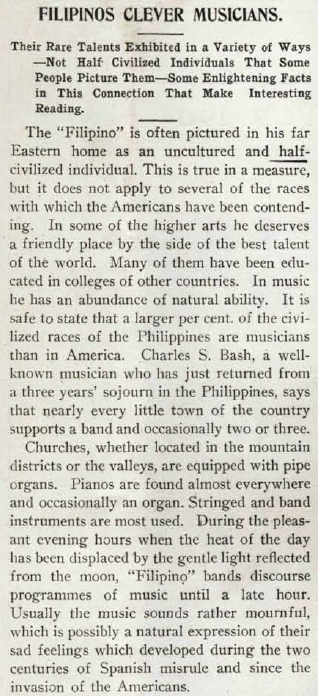
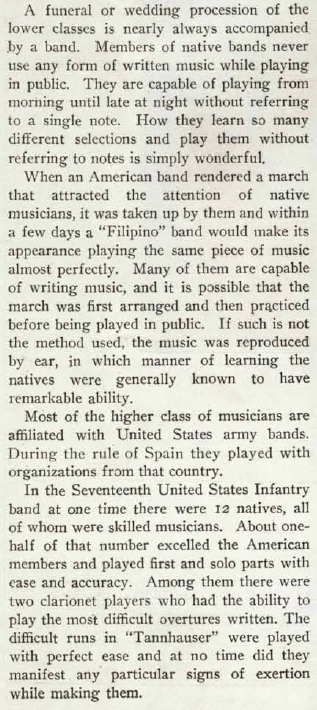 Source: |
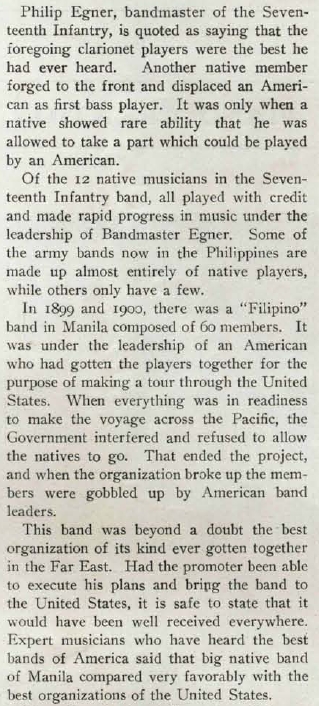 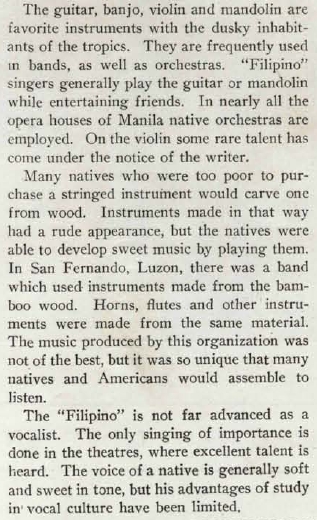 |
FILIPINOS CLEVER MUSICIANS.Their Rare Talents Exhibited in a Variety of Ways — Not Half Civilized Individuals That Some People Picture Them - Some Enlightening Facts in This Connection That Make Interesting Reading.The "Filipino" is often pictured in his far Eastern home as an uncultured and halfcivilized individual. This is true in a measure, but it does not apply to several of the races with which the Americans have been contending. In some of the higher arts he deserves a friendly place by the side of the best talent of the world. Many of them have been educated in colleges of other countries. In music he has an abundance of natural ability. It is safe to state that a larger per cent, of the civilized races of the Philippines are musicians than in America. Charles S. Bash, a wellknown musician who has just returned from a three years' sojourn in the Philippines, says that nearly every little town of the country supports a band and occasionally two or three. Churches, whether located in the mountain districts or the valleys, are equipped with pipe organs. Pianos are found almost everywhere and occasionally an organ. Stringed and band instruments are most used. During the pleasant evening hours when the heat of the day has been displaced by the gentle light reflected from the moon, "Filipino" bands discourse programmes of music until a late hour. Usually the music sounds rather mournful, which is possibly a natural expression of their sad feelings which developed during the two centuries of Spanish misrule and since the invasion of the Americans. A funeral or wedding procession of the lower classes is nearly always accompanied .by a band. Members of native bands never use any form of written music while playing in public. They are capable of playing from morning until late at night without referring to a single note. How they learn so many different selections and play them without referring to notes is simply wonderful. When an American band rendered a march that attracted the attention of native musicians, it was taken up by them and within a few days a "Filipino" band would make its appearance playing the same piece of music almost perfectly. Many of them are capable of writing music, and it is possible that the march was first arranged and then practiced before being played in public. If such is not the method used, the music was reproduced by ear, in which manner of learning the natives were generally known to have remarkable ability. Most of the higher class of musicians are affiliated with United States army bands. During the rule of Spain they played with organizations from that country. In the Seventeenth United States Infantry band at one time there were 12 natives, all of whom were skilled musicians. About onehalf of that number excelled the American members and played first and solo parts with ease and accuracy. Among them there were two clarionet players who had the ability to play the most difficult overtures written. The difficult runs in "Tannhauser" were played with perfect ease and at no time did they manifest any particular signs of exertion while making them. |
Philip Egner, bandmaster of the Seventeenth Infantry, is quoted as saying that the foregoing clarionet players were the best he had ever heard. Another native member forged to the front and displaced an American as first bass player. It was only when a native showed rare ability that he was allowed to take a part which could be played by an American. Of the 12 native musicians in the Seventeenth Infantry band, all played with credit and made rapid progress in music under the leadership of Bandmaster Egner. Some of the army bands now in the Philippines are made up almost entirely of native players, while others only have a few. In 1899 and 1900, there was a "Filipino" band in Manila composed of 60 members. It was under the leadership of an American who had gotten the players together for the purpose of making a tour through the United States. When everything was in readiness to make the voyage across the Pacific, the Government interfered and refused to allow the natives to go. That ended the project, and when the organization broke up the members were gobbled up by American band leaders. This band was beyond a doubt the best organization of its kind ever gotten together in the Far East. Had the promoter been able to execute his plans and bring the band to the United States, it is safe to state that it would have been well received everywhere. Expert musicians who have heard the best bands of America said that big native band of Manila compared very favorably with the best organizations of the United States. The guitar, banjo, violin and mandolin are favorite instruments with the dusky inhabitants of the tropics. They are frequently used in bands, as well as orchestras. "Filipino" singers generally play the guitar or mandolin while entertaining friends. In nearly all the opera houses of Manila native orchestras are employed. On the violin some rare talent has come under the notice of the writer. Many natives who were too poor to purchase a stringed instrument would carve one from wood. Instruments made in that way had a rude appearance, but the natives were able to develop sweet music by playing them. In San Fernando, Luzon, there was a band which used- instruments made from the bamboo wood. Horns, flutes and other instruments were made from the same material. The music produced by this organization was not of the best, but it was so unique that many natives and Americans would assemble to listen. The "Filipino" is not far advanced as a vocalist. The only singing of importance is done in the theatres, where excellent talent is heard. The voice of a native is generally soft and sweet in tone, but his advantages of study in vocal culture have been limited. |
MANNELLO AT WORLD'S FAIR.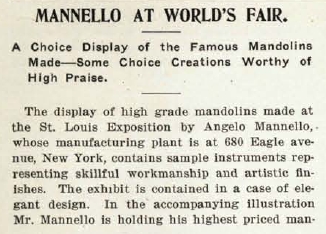 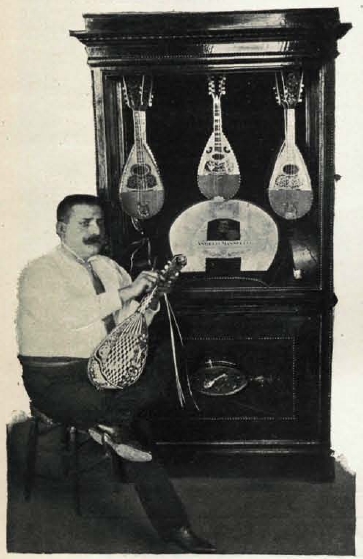 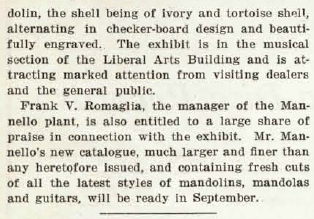 MANNELLO AT WORLD'S FAIR.A Choice Display of the Famous Mandolins Made—Some Choice Creations Worthy of High Praise.The display of high grade mandolins made at the St. Louis Exposition by Angelo Mannello, whose manufacturing plant is at 680 Eagle avenue, New York, contains sample instruments representing skillful workmanship and artistic finishes. The exhibit is contained in a case of elegant design. In the accompanying illustration Mr. Mannello is holding his highest priced mandolin, the shell being of ivory and tortoise shell, alternating in checker-board design and beautifully engraved. The exhibit is in the musical section of the Liberal Arts Building and is attracting marked attention from visiting dealers and the general public. Frank V. Romaglia, the manager of the Mannello plant, is also entitled to a large share of praise in connection with the exhibit. Mr. Mannello's new catalogue, much larger and finer than any heretofore issued, and containing fresh cuts of all the latest styles of mandolins, mandolas and guitars, will be ready in September. Source: Siehe auch / see also: Manello mandolin in the Metropolitan Museum of Art Weitere Links / more Manello links: https://pinboard.in/u:mandoisland/t:angelo-manello/ |
WALDO CONTRACT FOR 1,000 MANDOLINS.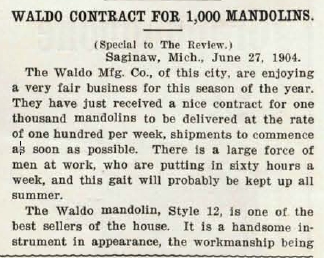 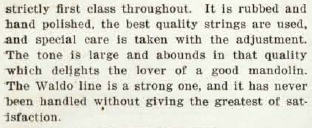 (Special to The Review.) Saginaw, Mich., June 27, 1904. The Waldo Mfg. Co., of this city, are enjoying a very fair business for this season of the year. They have just received a nice contract for one thousand mandolins to be delivered at the rate of one hundred per week, shipments to commence as soon as possible. There is a large force of men at work, who are putting in sixty hours a week, and this gait will probably be kept up all summer. The Waldo mandolin, Style 12, is one of the best sellers of the house. It is a handsome instrument in appearance, the workmanship being strictly first class throughout. It is rubbed and hand polished, the best quality strings are used, and special care is taken with the adjustment. The tone is large and abounds in that quality which delights the lover of a good mandolin. The Waldo line is a strong one, and it has never been handled without giving the greatest of satisfaction. Source: |
| Wenn
sie diese Seite
ohne Navigationsleiste angezeigt bekommen, dann klicken sie hier um die MandoIsland Homepage zu öffen: |
 |